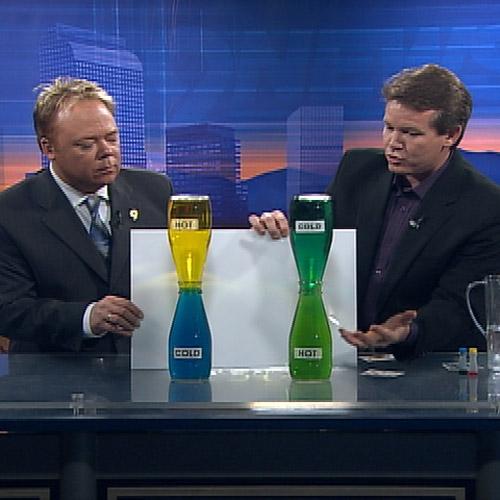Cool, crisp, clean mountain air has long been an important reason why people move to Colorado. Unfortunately, the air in the city of Denver isn't quite so clean. By the 1970s, the pollution hanging over the city had a name – the brown cloud. Denver's location at the foot of the Rocky Mountains makes it prone to temperature inversions in which warm air traps cooler air near the ground, preventing pollutants from rising into the atmosphere. Learn more about temperature inversions with this eye-catching, hands-on science experiment.
Denver’s Brown Cloud
Clean air has long been an important reason why people move to Colorado.

Here's What You'll Need
-
Four empty identical bottles (mouth of the bottle should be at least 1 1/2 inches in diameter)
-
Access to warm and cold water
-
Food coloring (yellow and blue)
-
3 x 5 inch index card or an old playing card
Experiment
- Fill two bottles with warm water from the tap and the other two bottles with cold water. Use food coloring to color the warm water yellow and the cold water blue. Each bottle must be filled to the brim with water.
- Hot over cold: Place the index card or old playing card over the mouth of one of the warm water bottles. Hold the card in place as you turn the bottle upside down and rest it on top of one of the cold water bottles. The bottles should be positioned so that they are mouth to mouth with the card separating the two liquids. You may want to do this over a sink.
- Carefully slip the card out from in between the two bottles. Make sure that you are holding onto the top bottle when you remove the card. Observe what happens to the colored liquids in the two bottles.
- Cold over hot: Repeat steps 2 and 3, but this time place the bottle of cold water on top of the warm water. Observe what happens.
How Does It Work?
Hot air balloons rise because warm air is lighter than cold air. Similarly, warm water is lighter in weight or less dense than cold water. When the bottle of warm water is placed on top of the cold water, the more dense cold water stays in the bottom bottle and the less dense warm water is confined to the top bottle. However, when the cold water bottle rests on top of the warm water, the less dense warm water rises to the top bottle and the cold water sinks. The movement of the water is clearly seen as the yellow and blue food coloring mix, creating a green liquid.
The movement of warm and cold water inside the bottles is referred to as the convection current. In our daily life, warm currents can occur in oceans, like the warm Gulf Stream moving up north along the American Eastern Seaboard. Convection currents in the atmosphere are responsible for the formation of thunderstorms as the warm and cold air masses collide.
Although the bottles whose colored liquids mix are more interesting to watch, the other set of warm and cold water bottles helps to illustrate another important phenomenon that occurs in the atmosphere during the winter months. During daylight hours, the sun heats the surface of the earth and the layer of air closest to the earth. This warm air rises and mixes with other atmospheric gases. When the sun goes down, the less dense warm air high up in the atmosphere often blankets the colder air that rests closer to the surface of the earth. Because the colder air is more dense than the warm air, the colder air is trapped close to the earth and the atmospheric gases do not mix. This is commonly referred to as temperature inversion.
Additional Info
What are the results of temperature inversion? Air pollution is more noticeable during a temperature inversion since pollutants such as car exhaust are trapped in the layer of cold air close to the earth. As a result, state agencies in many parts of the country oxygenate automobile fuels during winter months with additives like MTBE in an attempt to reduce the harmful effects of trapped pollution. This trapped pollution is what causes the “brown cloud” effect. Wind or precipitation can help alleviate the brown cloud effect by stirring up and breaking up the warm layer of air that traps the cold air and pollution down near the surface of the earth.
